Related Research Articles

Pablo Ruiz Picasso was a Spanish painter, sculptor, printmaker, ceramicist, and theatre designer who spent most of his adult life in France. One of the most influential artists of the 20th century, he is known for co-founding the Cubist movement, the invention of constructed sculpture, the co-invention of collage, and for the wide variety of styles that he helped develop and explore. Among his most famous works are the proto-Cubist Les Demoiselles d'Avignon (1907) and the anti-war painting Guernica (1937), a dramatic portrayal of the bombing of Guernica by German and Italian air forces during the Spanish Civil War.

Olga Picasso was a ballet dancer in the Ballets Russes, directed by Sergei Diaghilev and based in Paris. There she met and married the artist Pablo Picasso, served as one of his early muses, and was the mother of their son, Paul (Paulo).

The Menil Collection, located in Houston, Texas, refers either to a museum that houses the art collection of founders John de Menil and Dominique de Menil, or to the collection itself of paintings, sculptures, prints, drawings, photographs and rare books.

Marie-Thérèse Walter was a French model and lover of Pablo Picasso from 1927 to about 1935 and the mother of their daughter Maya Widmaier-Picasso. Their relationship began when she was seventeen years old; he was 45 and married to his first wife, Olga Khokhlova. It ended after Picasso moved on to his next relationship, with artist Dora Maar. Walter is known as Picasso's "golden muse" and inspired numerous artworks and sculptures that he created of her during their relationship.
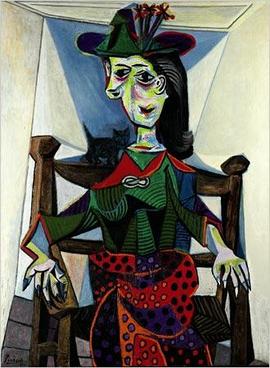
Dora Maar au Chat is an oil-on-canvas painting by Pablo Picasso. It was painted in 1941 and depicts Dora Maar, the artist's lover, seated on a chair with a small cat perched on her shoulders. The painting is listed as one of the most expensive paintings, after achieving a price of $95 million at Sotheby's on 3 May 2006. It is currently the sixth-highest-selling painting by Picasso.
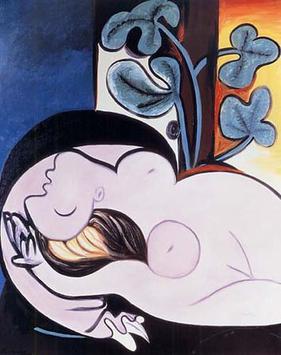
Nude in a Black Armchair is an oil on canvas painting by Pablo Picasso. Painted on 9 March 1932, a time at which Picasso lived in Boisgeloup outside Paris, it is the first and largest of a series of paintings Picasso completed that year of his mistress Marie-Thérèse Walter. The painting was purchased by Les Wexner at Christie's auction in 1999 for the value of $45.1 million.
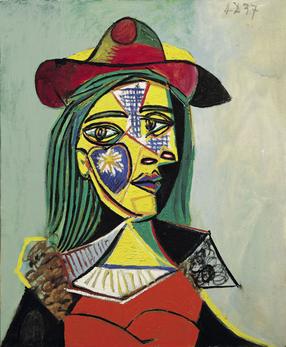
The Woman in Hat and Fur Collar is a painting by Pablo Picasso executed in 1937 and exhibited at the National Art Museum of Catalonia in Barcelona, Spain.
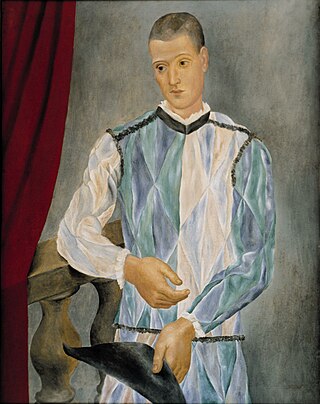
Pablo Picasso and the Ballets Russes collaborated on several productions. Pablo Picasso's Cubist sets and costumes were used by Sergei Diaghilev in the Ballets Russes's Parade, Le Tricorne, Pulcinella, and Cuadro Flamenco. Picasso also drew a sketch with pen on paper of La Boutique fantasque, and designed the drop curtain for Le Train Bleu, based on his painting Two Women Running on the Beach, 1922.

Jacqueline Picasso or Jacqueline Roque was the muse and second wife of Pablo Picasso. Their marriage lasted 12 years until his death, during which time he created over 400 portraits of her, more than any of Picasso's other lovers.
Pierre Le Guennec is a retired French electrician who announced, in 2010, that he was in possession of 271 undocumented, never before seen works by Pablo Picasso that were estimated to be worth at least 60 million euros.

La Lecture is a painting by Spanish artist Pablo Picasso completed in January 1932. The oil painting depicts Picasso's mistress and muse, Marie-Thérèse Walter, asleep with a book upon her lap. The painting led to the breakup of Picasso's marriage to Olga Khokhlova after she saw it at a retrospective exhibition and realised that the facial features were not her own. The painting went to auction in 1989 and in 1996, where it failed to sell. In January 2011, it was announced that La Lecture would be going to auction on 8 February. The painting, which had not been seen in Europe since the exhibition, was then displayed at Sotheby's in Paris.
Picasso: Magic, Sex, & Death (2001) is a three-episode Channel 4 film documentary series on Pablo Picasso (1881–1973) presented by the artist's friend and biographer John Richardson, and directed by Christopher Bruce or British art critic Waldemar Januszczak, who was also the series director. On-screen contributors include Picasso descendants such as Paloma Picasso, Bernard Ruiz-Picasso, Diana Widmaier-Picasso, Maya Picasso, and Claude Picasso; along with authorities such as Mary Ann Caws, Billy Klüver, Gérard Régnier, James Lord, Bernard Minoret, Robert Rosenblum, Linda Gasman, Marilyn McCully, David Gilmore and Gertje Utley; one former mistress ; and one flirtation.
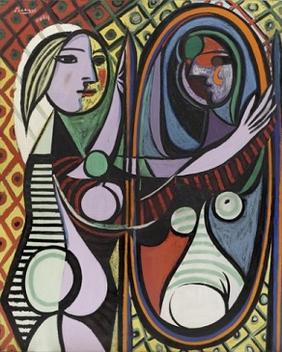
Girl before a Mirror(French: Jeune fille devant un miroir) is an oil on canvas painting by Pablo Picasso, which he created in 1932. The painting is a portrait of Picasso's mistress and muse, Marie-Thérèse Walter, who is depicted standing in front of a mirror looking at her reflection. It is housed in the collection of the Museum of Modern Art in New York City.
Bernard Ruiz-Picasso is a businessman and art collector. He is the grandson of Pablo Picasso and the son of Paul and Christine Ruiz-Picasso. He curates international exhibitions dedicated to Pablo Picasso.
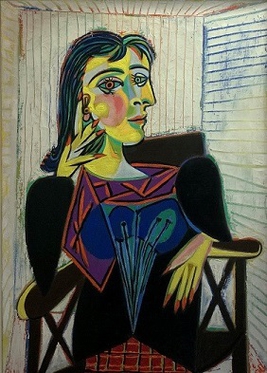
Portrait of Dora Maar is a 1937 oil on canvas painting by Pablo Picasso. It depicts Dora Maar,, the painter's lover, seated on a chair. It is part of the collection of the Musée Picasso, in Paris, where it is considered to be one of Picasso's masterpieces.

Le Repos is an oil-on-canvas painting created by Pablo Picasso in 1932. It depicts a portrait of Marie-Thérèse Walter, the artist's lover and muse, in a sleeping pose. The painting was produced in the midst of their relationship and is a demonstration of Picasso's love for his mistress. Le Repos was one of a series of sleeping portraits of Walter that Picasso created in 1932. On 14 May 2018, the painting achieved a value of $36.9 million when it was sold at Sotheby's auction.

Femme au Chien is an oil-on-canvas painting by Pablo Picasso, which he painted in 1962. It is a portrait of Picasso's second wife, Jacqueline Roque, and their dog Kaboul, an Afghan Greyhound. The painting is an illustration of the great affection that Picasso displayed for both of the subjects in the portrait and has elements of the cubist style that he pioneered. It was produced in Picasso's later years when the couple was living at Notre-Dame-de-Vie, near Mougins, France. On 14 May 2019, it was sold at Sotheby's auction for almost $55 million and is now housed in the collection of Wynn Fine Art in Florida.

Femme au béret et à la robe quadrillée is an oil-on-canvas painting by Pablo Picasso, which he created in 1937. It is a portrait of Marie-Thérèse Walter, Picasso's lover and muse during this period and was created with elements of Cubism. The painting signifies a transition in their relationship by combining Walter's profile with that of Picasso's new lover, the Surrealist photographer Dora Maar, with whom he began a relationship in 1936. This portrait was produced in the same year as Guernica and The Weeping Woman, a significant phase in Picasso's artistic career. On 28 February 2018, it was sold at Sotheby's auction for £49.8 million, making it one of the most expensive paintings ever sold at an auction in Europe.
Femme à la montre is a 1932 oil-on-canvas portrait by Pablo Picasso of his muse Marie-Thérèse Walter. Painted during Picasso's annus mirabilis, the work depicts Walter sitting upright in an armchair.
References
- ↑ McKenna, Kristine (27 February 1994). "The Feminine Mistake". The Washington Post. Retrieved 31 December 2020.
- ↑ "Woman in a Red Armchair". Menil Collection. Retrieved 31 December 2020.
- ↑ "Studio will spotlight work of fugitive in Menil vandalism - Houston Chronicle". Chron.com. 24 October 2012. Retrieved 2012-11-09.